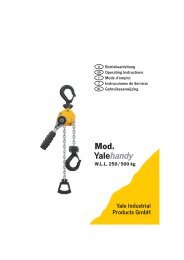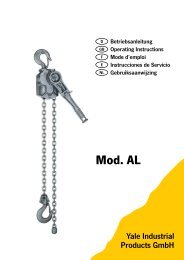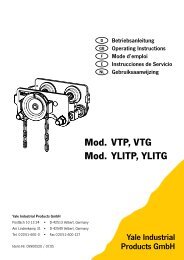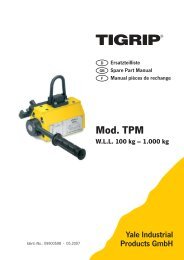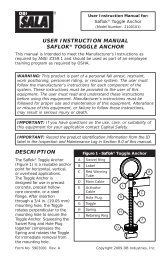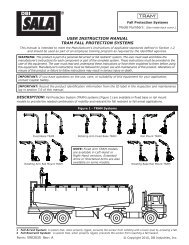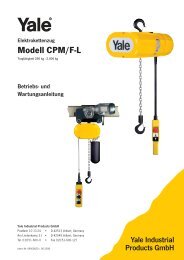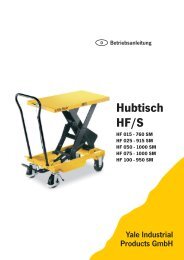Bedienungsanleitung Modell TKG vhs - Hebetechnik GmbH
Bedienungsanleitung Modell TKG vhs - Hebetechnik GmbH
Bedienungsanleitung Modell TKG vhs - Hebetechnik GmbH
Erfolgreiche ePaper selbst erstellen
Machen Sie aus Ihren PDF Publikationen ein blätterbares Flipbook mit unserer einzigartigen Google optimierten e-Paper Software.
D<br />
GB<br />
Mod.<br />
Betriebsanleitung<br />
Operating Instructions<br />
<strong>TKG</strong> <strong>vhs</strong><br />
Yale Industrial<br />
Products <strong>GmbH</strong>
D<br />
GB<br />
Deutsch<br />
Seite 2<br />
Page 3<br />
D<br />
VORWORT<br />
Diese Betriebsanleitung ist von jedem Bediener<br />
vor der ersten Inbetriebnahme sorgfältig<br />
zu lesen. Sie soll helfen das Produkt kennenzulernen<br />
und dessen bestimmungsgemässe<br />
Einsatzmöglichkeiten zu nutzen.<br />
Die Betriebsanleitung enthält wichtige Hinweise<br />
um das Produkt sicher, sachgerecht und<br />
wirtschaftlich zu betreiben. Ihre Beachtung<br />
hilft Gefahren zu vermeiden, Reparaturkosten<br />
und Ausfallzeiten zu vermindern und die Zuverlässigkeit<br />
und Lebensdauer des Produktes<br />
zu erhöhen. Diese Betriebsanleitung muss<br />
ständig am Einsatzort des Produktes verfügbar<br />
sein. Neben der Betriebsanleitung und den<br />
im Verwenderland und an der Einsatzstelle<br />
geltenden verbindlichen Regelungen zur Unfallverhütungsvorschrift<br />
sind auch die anerkannten<br />
Regeln für sicherheits- und fachgerechtes<br />
Arbeiten zu beachten.<br />
BESTIMMUNGSGEMÄSSE<br />
VERWENDUNG<br />
- Das Produkt ist für den Transport von palettierten<br />
Gütern und Waren geeignet, die aufgrund<br />
ihrer Abmessung sicher auf den Gabelzinken<br />
gelagert werden können und deren<br />
Gewicht mindestens 20% der Nenntragfähigkeit<br />
(WLL) beträgt.<br />
Achtung: Unbedingt Hinweise zur Verwendung<br />
auf Baustellen beachten!<br />
- Die auf dem Gerät angegebene Tragfähigkeit<br />
(WLL) ist die maximale Last, die nicht<br />
überschritten werden darf.<br />
- Das Anhängen des Lastaufnahmemittels<br />
darf nur an Hubgeräten (Krane usw.) erfolgen,<br />
die mit Hakensicherungen ausgestattet<br />
sind. Der Haken muss sich in der Öse<br />
frei bewegen können.<br />
- Die angegebene Tragfähigkeit gilt bei einem<br />
Abstand des Lastschwerpunktes von<br />
400 mm bzw. 500 mm vom Holm (halbe<br />
Zinkenlänge).<br />
-Außerhalb des bodennahen Bereiches, bzw.<br />
auf Baustellen, muss die Last durch die mitgelieferte<br />
straff zu spannende Sicherungskette<br />
gesichert sein. Zum Befestigen der<br />
Kette sind am senkrechten Holm Ösen angebracht.<br />
- Bei ordnungsgemäßer Positionierung der<br />
Last (Fig. 1) muss der Neigungswinkel min.<br />
5° nach hinten erreichen.<br />
- Beim Transport von losen Materialien wie<br />
z.B. Dachziegel oder Bausteinen auf Baustellen<br />
muss zum Schutz vor Herabfallen<br />
zusätzlich ein geeignetes Netz oder ein geeigneter<br />
Käfig verwendet werden.<br />
Hinweis: Die Öffnungen der Schutzeinrichtung<br />
muss kleiner als 50 mm 2 sein (siehe<br />
Merkblatt „paketierte Steine auf Baustellen“<br />
ZH 1/335).<br />
- Es ist darauf zu achten, nur unbeschädigte<br />
Paletten zu verwenden.<br />
- Das Heben oder der Transport von Lasten<br />
ist zu vermeiden, solange sich Personen im<br />
Gefahrenbereich der Last befinden.<br />
- Der Aufenthalt unter einer angehobenen Last<br />
ist verboten.<br />
- Lasten nicht über längere Zeit oder unbeaufsichtigt<br />
in angehobenem oder gespanntem<br />
Zustand belassen.<br />
- Der Bediener darf eine Lastbewegung erst<br />
dann einleiten, wenn er sich davon überzeugt<br />
hat, dass die Last richtig angeschlagen ist.<br />
- Beim Einhängen des Lastaufnahmemittels<br />
ist vom Bediener darauf zu achten, dass das<br />
Lastaufnahmemittel so bedient werden<br />
kann, dass der Bediener weder durch das<br />
Gerät selbst noch durch das Tragmittel oder<br />
die Last gefährdet wird.<br />
- Die Lastaufnahmemittel können in einer<br />
Umgebungstemperatur zwischen –40° C<br />
und +100° C arbeiten. Bei Extrembedingungen<br />
sollte mit dem Hersteller Rücksprache<br />
genommen werden.<br />
-Die Unfallverhütungs- bzw. Sicherheitsvorschriften<br />
für Lastaufnahmemittel des<br />
jeweiligen Landes, in dem das Lastaufnahmemittel<br />
eingesetzt wird, sind unbedingt<br />
zu beachten.<br />
- Bei Funktionsstörungen ist das Lastaufnahmemittel<br />
sofort außer Betrieb zu setzen.<br />
SACHWIDRIGE VERWENDUNG<br />
- Die angegebene Tragfähigkeit (WLL) darf<br />
nicht überschritten werden.<br />
- An dem Lastaufnahmemittel dürfen keine<br />
Veränderungen durchgeführt werden.<br />
- Die Benutzung des Lastaufnahmemittels<br />
zum Transport von Personen ist verboten.<br />
- Beim Transport der Last ist eine Pendelbewegung<br />
und das Anstoßen an Hindernisse<br />
zu vermeiden.<br />
2<br />
- Der Transport des Hebegutes sollte immer<br />
langsam und vorsichtig durchgeführt<br />
werden.<br />
- Die Belastung des Lastaufnahmemittels mit<br />
seitlichen Zugkräften ist verboten.<br />
- Die lichte Höhe der Krangabel und die Zinkenlänge<br />
dürfen von dem Hebegut nicht<br />
überschritten werden.<br />
- Mit der Krangabel dürfen nur Güter transportiert<br />
werden, die auf Paletten fest<br />
verschnürt sind bzw. Güter die aufgrund<br />
ihrer Form und Größe direkt von den Zinken<br />
aufgenommen werden können.<br />
- Das Gewicht der aufgenommenen Last muss<br />
mehr als 20% der angegebenen Tragfähigkeit<br />
betragen. Bei geringerer Belastung erfolgt<br />
keine Einstellung der Aufhängeöse.<br />
Achtung: Beim Anheben der beladenen<br />
Krangabel dürfen die Zinken nicht nach vorn<br />
geneigt sein (Fig. 1).<br />
- Lastaufnahmemittel nicht aus großer Höhe<br />
fallen lassen.<br />
PRÜFUNG VOR DER ERSTEN<br />
INBETRIEBNAHME<br />
Vor der ersten Inbetriebnahme ist das Lastaufnahmemittel<br />
einer Prüfung durch einen<br />
Sachkundigen zu unterziehen. Diese Prüfung<br />
besteht im Wesentlichen aus einer Sicht- und<br />
Funktionsprüfung. Diese Prüfungen sollen<br />
sicherstellen, dass sich das Lastaufnahmemittel<br />
in einem sicheren Zustand befindet und<br />
gegebenenfalls Mängel bzw. Schäden festgestellt<br />
und behoben werden.<br />
Als Sachkundige können z.B. die Wartungsmonteure<br />
des Herstellers oder Lieferanten<br />
angesehen werden. Der Unternehmer kann<br />
aber auch entsprechend ausgebildetes Fachpersonal<br />
des eigenen Betriebes mit der<br />
Prüfung beauftragen.<br />
PRÜFUNG VOR ARBEITSBEGINN<br />
- Das gesamte Lastaufnahmemittel ist auf<br />
Beschädigungen, Risse oder Verformungen<br />
hin zu überprüfen.<br />
- Richtige Position der Anschlagbolzen (Fig. 3)<br />
beachten.<br />
- Es ist darauf zu achten, dass der Absteckbolzen<br />
und die Anschlagbolzen (6, 8, 9) am<br />
Rahmen gesichert sind.<br />
- Die Gabelzinken müssen verriegelt sein<br />
(Fig. 2).<br />
- Lackbeschädigungen sind auszubessern, um<br />
Korrosion zu vermeiden. Die Gabelzinken<br />
sind von Schmutz, Öl, Fett und Eis beim Einsatz<br />
im Freien zu säubern.<br />
- Es sind nur Kranhaken mit Hakensicherungen<br />
einzusetzen.
GEBRAUCH DES<br />
LASTAUFNAHMEMITTELS (Fig. 4)<br />
Entsprechend der zu transportierenden Last<br />
sind die Zinken und der Holm auf die erforderliche<br />
Breite bzw. Höhe einzustellen und<br />
durch die Verriegelung zu sichern.<br />
Einstellung der Gabelzinkenbreite<br />
-Verriegelung durch Drehen öffnen.<br />
- Zinke auf die erforderliche Breite einstellen.<br />
-Verriegelung durch Drehen aktivieren.<br />
Achtung: Verriegelung muss sichtbar im<br />
Rahmen eingerastet sein (Fig. 2).<br />
Einstellung der Höhe des Grundgestell-<br />
Oberteils (Fig. 4)<br />
- Sicherungsclip entfernen.<br />
- Den Holm (2) nach oben ziehen.<br />
- Bolzenposition wählen und Absteckbolzen<br />
(6) einführen.<br />
-Absteckbolzen durch Sicherungsclip sichern.<br />
Einstellung auf den Lastschwerpunkt<br />
Aufgrund der angehängten Last verschiebt sich<br />
die Aufhängeöse (1) im oberen Holm.<br />
Mit dem Anschlagbolzen (9) lässt sich das<br />
Lastaufnahmemittel auf zwei Lastschwerpunkte<br />
einstellen (Fig. 3).<br />
- Sicherungsclip entfernen.<br />
- Bolzenposition wählen.<br />
- Bolzen durch Sicherungsclip sichern.<br />
- Die unbeladene Krangabel hat am Hubgerät<br />
eine leichte Zinkenneigung bis ca. 3°<br />
nach vorn. Dieses dient zum besseren Einfahren<br />
der Zinken unter die Last.<br />
-Wird eine Last angehoben, neigt sich die Last<br />
ca. 5° nach hinten.<br />
Achtung: Kleinste Last von 20% der Nenntragfähigkeit<br />
berücksichtigen.<br />
- Als Bediener immer neben der Krangabel<br />
stehen und einen Sicherheitsabstand von<br />
einer Armlänge einhalten.<br />
- Das Zugseil oder die Zugkette des Kranes<br />
muss immer Senkrecht über die Aufhängeöse<br />
stehen um eine plötzliche Lastbewegung<br />
zu vermeiden<br />
Achtung: Der Lastpunkt darf sich nicht über<br />
die maximale Schwerpunktlage (Fig. 3) hinaus<br />
verschieben (Einstellungen beachten).<br />
Verwendung der Sicherungskette (auf<br />
Baustellen unbedingt erforderlich)<br />
- Mitgelieferte Sicherungskette um das palettierte<br />
Hebegut schlingen und straff ziehen.<br />
-Kette in die vorgesehene Öse einführen und<br />
einhängen.<br />
Anheben bzw. Absetzen der Last<br />
Achtung: Die kleinste Last, die angehoben<br />
werden darf, beträgt 20% der Nenntragfähigkeit.<br />
- Last langsam anheben bzw. absetzen um<br />
ein Kippen der Last zu verhindern.<br />
- Hebezeug eventuell nachjustieren, damit<br />
sich die Aufhängeöse immer senkrecht unter<br />
dem Hebezeug befindet.<br />
-Erst wenn die Aufhängeöse ihre Endlage erreicht<br />
hat weitere Lastbewegungen einleiten.<br />
PRÜFUNG/WARTUNG<br />
Die Prüfung ist mindestens einmal jährlich,<br />
bei schweren Einsatzbedingungen in kürzeren<br />
Abständen, von einem Sachkundigen vorzunehmen.<br />
Die Prüfungen sind im Wesentlichen<br />
Sicht- und Funktionsprüfungen, wobei der<br />
Zustand von Bauteilen hinsichtlich Beschädigung,<br />
Verschleiß, Korrosion oder sonstigen Veränderungen<br />
beurteilt, sowie die Vollständigkeit<br />
und Wirksamkeit der Sicherheitseinrichtungen<br />
festgestellt werden muss.<br />
Reparaturen dürfen nur von Fachwerkstätten,<br />
die Orginal TIGRIP Ersatzteile verwenden,<br />
durchgeführt werden.<br />
Die Instandsetzung oder der Austausch von<br />
verschlissenen Bauteilen ist unbedingt erforderlich,<br />
wenn sichtbare Schäden vorliegen.<br />
Die Prüfungen sind vom Betreiber<br />
zu veranlassen.<br />
3<br />
English<br />
GB<br />
INTRODUCTION<br />
All users must read these operating<br />
instructions carefully prior to the initial<br />
operation. These instructions are intended to<br />
acquaint the user with the lifting tackle and<br />
enable him to use it to the full extent of its<br />
intended capabilities. The operating instructions<br />
contain important information on<br />
how to handle the lifting tackle in a safe,<br />
correct and economic way. Acting in<br />
accordance with these instructions helps to<br />
avoid dangers, reduce repair cost and down<br />
time and to increase the reliability and lifetime<br />
of the lifting tackle. This operating instruction<br />
must always be available for consultation in<br />
the area where the lifting tackle is in operation.<br />
Apart from the operating instructions and the<br />
accident prevention act valid for the respective<br />
country and area where the lifting tackle is<br />
being used, also the commonly accepted<br />
regulations for safe and professional work<br />
must be adhered to.<br />
CORRECT OPERATION<br />
- The lifting tackle is suitable for the transport<br />
of palletized goods, which on account of their<br />
dimensions can be safely placed on the<br />
forks. The load weight must not be less than<br />
20% of the nominal capacity (WLL).<br />
Attention: Instructions for the application<br />
on building sites must be strictly adhered<br />
to!<br />
- The capacity indicated on the lifting tackle<br />
is the maximum safe working load (WLL)<br />
which must never be exceeded.<br />
- The lifting tackle may only be attached to<br />
hoisting devices which are provided with<br />
safety latches. The hook must swivel freely<br />
in the suspension lug.<br />
- The indicated capacity applies to a distance<br />
of 400 mm resp. 500 mm between the load<br />
centre of gravity and the stationary base<br />
frame (half tine length).<br />
- Outside the immediate area of the floor, resp.<br />
on building sites, the load must be secured<br />
with a tight safety chain delivered with the<br />
lifting tackle. The stationary base frame is<br />
provided with lugs to accept the safety chain.<br />
- When the load is properly fitted (Fig. 1), the<br />
angle of inclination must be min 5° backwards.<br />
-Transportation of loose materials, e.g. tiles<br />
or bricks, on building sites must be additionally<br />
secured against falling by an adequate<br />
net or cage.<br />
Note: The openings in the protection device<br />
must be smaller than 50 mm 2 .
- Make sure that the pallets used are in perfect<br />
condition.<br />
- Do not lift or transport loads while personnel<br />
are in the danger zone.<br />
- Do not allow personnel to pass under a suspended<br />
load.<br />
-A load must not be suspended or left unattended<br />
for a longer period of time.<br />
- The operator may not move the load until<br />
he is convinced that the load is correctly attached.<br />
- During positioning of the lifting tackle, the<br />
operator must ensure that neither the fork,<br />
slings or load pose a danger to himself or<br />
other personnel.<br />
- The lifting tackle may only be used at<br />
ambient temperatures between –40° C and<br />
+100° C. For extreme temperatures<br />
exceeding this range, please contact the<br />
manufacturer.<br />
- The accident prevention act and safety regulations<br />
valid in the country of operation are<br />
to be strictly adhered to at all times.<br />
- If defects are found, stop using the lifting<br />
tackle immediately.<br />
INCORRECT OPERATION<br />
- Do not exceed the rated lifting capacity<br />
(WLL).<br />
- Do not tamper with lifting tackle.<br />
- It is forbidden to use the lifting tackle for the<br />
transport personnel.<br />
- When transporting loads ensure that the load<br />
does not swing or come into contact with<br />
other objects.<br />
- Always transport the load slowly and carefully.<br />
- It is forbidden to apply side-pull forces to the<br />
lifting tackle.<br />
- The load may not extend beyond the clearance<br />
height of the lifting tackle or the length<br />
of the tines.<br />
- The lifting tackle may only be used for the<br />
transport of goods which are firmly lashed<br />
on pallets resp. commodities, which – on<br />
account of their shape and size – can be<br />
picked up by the tines directly.<br />
- The automatic balancing system requires a<br />
minimum load of 20% of the rated capacity<br />
(WLL). When loaded below 20% of WLL,<br />
the suspension lug will not react and the tines<br />
will tilt downwards (Fig. 1).<br />
- Do not allow the lifting tackle to fall from a<br />
great height.<br />
INSPECTION BEFORE INITIAL<br />
OPERATION<br />
Each lifting tackle must be inspected prior to<br />
initial operation by a competent person. The<br />
inspection is visual and functional. This inspec-<br />
tion shall establish that the tackle is safe and<br />
has not been damaged by incorrect transport<br />
or storage. Inspections should be made by a<br />
representative of the manufacturer or the supplier,<br />
although the company can assign its own<br />
suitably trained personnel.<br />
INSPECTIONS BEFORE STARTING<br />
WORK<br />
- Check the complete crane fork for damage,<br />
cracks or deformations.<br />
- Check correct position of the stop pins<br />
(Fig. 3).<br />
- Ensure that the socket pin (6), the setting<br />
pin (8) and the stop pin (9) are locked.<br />
- The fork tines must be locked (Fig. 2).<br />
-Paint damages should be repaired to prevent<br />
corrosion. The tines must be free from<br />
soiling, oil, grease and – in case of outdoor<br />
operation - ice -.<br />
- Crane hooks must be provided with safety<br />
latches.<br />
USING THE CRANE FORKS (Fig. 4)<br />
Fork tines and base frame have to be adjusted<br />
to the required width resp. height of the load<br />
to be transported and locked accordingly.<br />
Adjustment of fork tine width<br />
- Open the locking mechanism by turning the<br />
spring bolt.<br />
-Adjust the fork tines to the required width.<br />
-Activate the locking mechanism by turning<br />
the spring bolt.<br />
Attention: The locking mechanism must be<br />
visibly engaged in the frame (Fig. 2).<br />
Height adjustment of the movable<br />
base frame (Fig. 4)<br />
-Remove the safety clip.<br />
- Pull the movable base frame (2) upwards.<br />
- Select correct pin position and insert the<br />
socket pins (6) accordingly.<br />
- Secure the socket pins with the safety clips.<br />
Adjustment to the load centre<br />
of gravity<br />
When lifting the load, the suspension lug (1)<br />
will automatically move on the upper base<br />
frame until seated.<br />
By means of the stop pin (9) the lifting tackle<br />
can be adjusted to two load centres of gravity<br />
(Fig. 3).<br />
-Remove safety clip.<br />
- Select stop pin position.<br />
- Secure stop pin with safety clip.<br />
-With the unloaded crane forks attached to<br />
the lifting appliance, the tines have a slight<br />
inclination of approx. 3o forwards. This allows<br />
comfortable entry of the tines under<br />
4<br />
the pallet or the load. When lifting the load,<br />
the tines will tilt approx. 5o backwards.<br />
Note: Minimum load must be 20% of the<br />
rated capacity.<br />
- The operator should always stand clear at<br />
the side of the crane forks with a safety distance<br />
of an arm length.<br />
- The lifting rope or chain of the crane must<br />
always be vertical over the suspension lug<br />
of the lifting tackle in order to avoid a sudden<br />
load movement.<br />
Attention: The load centre must not exceed<br />
the max. position of centre of gravity (Fig.<br />
3). (Adjustments should be observed).<br />
Using the safety chain (mandatory on<br />
building sites)<br />
- Loop the delivered safety chain around the<br />
lifting product and pull tight.<br />
-Feed the safety chain through the designated<br />
lug and secure.<br />
Lifting resp. lowering of the load<br />
Attention: The minimum load must be 20%<br />
of the rated capacity.<br />
- Always lift and lower the lifting tackle slowly<br />
in order to avoid tilting of the load.<br />
-Readjust the lifting device, if necessary, to<br />
ensure that the suspension lug is always<br />
positioned vertically below the hoist.<br />
-Further load movements may only be initiated<br />
after the suspension lug has reached its<br />
final position.<br />
INSPECTIONS AND SERVICE<br />
Inspections are to be made by a competent<br />
person at least once annually unless adverse<br />
working conditions dictate shorter periods. The<br />
clamp is to be inspected for damage, wear,<br />
corrosion or other irregularities and all safety<br />
devices have to be checked for completeness<br />
and effectiveness.<br />
Repairs may only be carried out by specialist<br />
workshops that use original TIGRIP spare<br />
parts.<br />
In case of obvious defects or damages the<br />
crane forks must be repaired and worn components<br />
replaced.<br />
Inspections are instigated by the user.
D<br />
GB<br />
Sachwidrige Verwendung<br />
Incorrect operation<br />
x max.<br />
F<br />
Pos. 1<br />
Pos. 2<br />
Lastschwerpunkt<br />
Load centre of gravity<br />
Fig. 1<br />
verriegelte Position<br />
locked position<br />
Öse für<br />
Sicherungskette<br />
Lug for safety chain<br />
Fig. 2<br />
Öse für<br />
Sicherungskette<br />
Lug for safety chain<br />
Fig. 3<br />
Pos. 1 Pos. 2<br />
x max. [mm] 400 500<br />
Palettenlänge [mm] 800 1000<br />
empfohlen (Euro-Palette quer) (Euro-Palette längs)<br />
5<br />
geöffnete Position<br />
open position<br />
Pallet length [mm] 800 1000<br />
recommended (Euro pallet lateral) (Euro pallet longitudinal)<br />
Pos. 1<br />
Pos. 2<br />
Lastschwerpunkt<br />
Load centre of gravity
Beschreibung<br />
1 Aufhängeöse<br />
2 Grundgestell Oberteil<br />
3 Grundgestell Unterteil<br />
4 Tragzinken<br />
5 Federriegel<br />
6 Absteckbolzen mit Klappstecker,<br />
Schlüsselring und Kette<br />
7 Deckel<br />
8 Anschlagbolzen mit Klappstecker<br />
9 Anschlagbolzen mit Klappstecker,<br />
Schlüsselring und Kette<br />
10 Handgriff<br />
11 Öse für Sicherungskette<br />
(nicht dargestellt)<br />
Description<br />
1 Suspension lug<br />
2 Movable base frame<br />
3 Stationary base frame<br />
4 Fork tine<br />
5 Spring pin<br />
6 Socket pin with locking device<br />
7 Cover<br />
8 Setting pin with locking device<br />
9 Stop pin with locking device<br />
10 Handle<br />
11 Lug for safety chain (not shown)<br />
10<br />
5<br />
6<br />
6<br />
8<br />
2<br />
3<br />
10<br />
1<br />
9<br />
Fig. 4<br />
4<br />
7
D<br />
GB<br />
EG Konformitätserklärung 2006/42/EG (Anhang II A)<br />
Hiermit erklären wir, dass das nachfolgend bezeichnete Lastaufnahmemittel aufgrund seiner Konzipierung und Bauart sowie in der von uns<br />
in Verkehr gebrachten Ausführung den einschlägigen grundlegenden Sicherheits- und Gesundheitsanforderungen der EG-Richtlinie Maschinen<br />
entspricht.<br />
Bei einer nicht mit uns abgestimmten Änderung des Lastaufnahmemittels verliert diese Erklärung ihre Gültigkeit. Weiterhin verliert diese EG-<br />
Konformitätserklärung ihre Gültigkeit, wenn die Maschine nicht entsprechend den in der Betriebsanleitung aufgezeigten bestimmungsgemäßen<br />
Einsatzfällen eingesetzt und die regelmäßig durchzuführenden Überprüfungen nicht ausgeführt werden.<br />
Produkt: Lastaufnahmemittel<br />
Typ: Krangabel <strong>TKG</strong> <strong>vhs</strong> Tragfähigkeit: 1.000 kg, 1.500 kg, 2.000 kg, 3.000 kg, 5.000 kg<br />
Serien Nr.: Seriennummernkreise für die einzelnen Tragfähigkeiten werden im Produktionsbuch festgehalten<br />
Einschlägige EG-Richtlinien: EG-Maschinenrichtlinie 2006/42/EG<br />
Angewandte Normen: ISO 12100; EN 349; EN 13155; BGV D6; BGR 500<br />
Qualitätssicherung: DIN EN ISO 9001<br />
EC Declaration of Conformity 2006/42/EC (Appendix II A)<br />
Hereby we declare, that the construction and commercialised execution of the below Lifting Equipment complies with the essential health<br />
and safety requirements of the EC Machinery Directive. The validity of this declaration will cease in case of any modification not being agreed<br />
with us previously.<br />
Furthermore, validity of this declaration will cease in case that the machine will not be operated correctly and in accordance to the operating<br />
instructions and/or not be inspected regularly.<br />
Product: Non-fixed load lifting attachment<br />
Type: Crane forks <strong>TKG</strong> <strong>vhs</strong> Capacity: 1.000 kg, 1.500 kg, 2.000 kg, 3.000 kg, 5.000 kg<br />
Serial no.: Serial numbers for the individual capacities are registered in the production book<br />
Relevant EC Directives: EC Machinery Directive 2006/42/EC<br />
Standards in particular: ISO 12100; EN 349; EN 13155; BGV D6; BGR 500<br />
Quality assurance: DIN EN ISO 9001<br />
Datum/Hersteller-Unterschrift 2007-07-04<br />
Date/Manufacturer‘s signature<br />
Dipl.-Ing. Andreas Oelmann<br />
Angaben zum Unterzeichner Leiter Qualitätswesen<br />
Identification of the signee Manager Quality assurance<br />
7
Germany and<br />
Export territories<br />
-European Headquarters-<br />
Yale Industrial Products <strong>GmbH</strong><br />
Am Lindenkamp 31<br />
42549 Velbert<br />
Phone: 00 49 (0)20 51/600-0<br />
Fax: 00 49(0)20 51/600-127<br />
Web Site: www.yale.de<br />
E-mail: central@yale.de<br />
Austria<br />
Yale Industrial Products <strong>GmbH</strong><br />
Gewerbepark, Wiener Straße 132a<br />
2511 Pfaffstätten<br />
Phone: 00 43(0)22 52/4 60 66-0<br />
Fax : 00 43 (0) 22 52/4 60 66-22<br />
Web Site: www.yale.at<br />
E-mail: zentrale@yale.at<br />
Netherlands<br />
Yale Industrial Products B.V.<br />
Grotenoord 30<br />
3341 LT Hendrik Ido Ambacht<br />
Phone: 00 31(0)78/6 82 59 67<br />
Fax : 00 31 (0)78/6825974<br />
Web Site: www.yaletakels.nl<br />
E-mail: information@yaletakels.nl<br />
Hungary<br />
Yale Industrial Products Kft.<br />
8000 Székesfehérvár<br />
Repülőtér<br />
Phone: 00 36 (06) 22/546-720<br />
Fax: 00 36 (06) 22/546-721<br />
Web Site: www.yale.de<br />
E-mail: info@yale-centraleurope.com<br />
France<br />
Yale Levage SARL<br />
Zone Industrielle des Forges<br />
18108 Vierzon Cedex<br />
Phone: 00 33 (0) 248 7185 70<br />
Fax : 00 33 (0)2487530 55<br />
Web Site: www.yale-levage.com<br />
E-mail: centrale@yale-levage.com<br />
United Kingdom<br />
Yale Industrial Products<br />
A trading division of<br />
Columbus McKinnon<br />
Corporation Ltd.<br />
Knutsford Way, Sealand Industrial Estate<br />
Chester CH1 4NZ<br />
Phone: 00 44(0)1244375375<br />
Fax : 00 44 (0)1244377403<br />
Web Site: www.yaleproducts.com<br />
E-mail: sales.uk@cmworks.com<br />
Yale Industrial Products<br />
(Northern Ireland)<br />
A trading division of<br />
Columbus McKinnon<br />
Corporation Ltd.<br />
Unit 12, Loughside Industrial Park<br />
Dargan Crescent, Belfast BT3 9JP<br />
Phone: 00 44(0) 28 90 7714 67<br />
Fax : 00 44 (0)2890 771473<br />
Web Site: www.yaleproducts.com<br />
E-mail: sales.uk@cmworks.com<br />
Italy<br />
Columbus McKinnon Italia Srl<br />
Via P. Picasso, 32<br />
20025 Legnano (MI) Italy<br />
Phone: 00390331576329<br />
Fax : 00 39 0331468262<br />
Web Site: www.cmworks.com<br />
E-mail: info@cmco.it<br />
Reg. Nr. 151<br />
Certified since November 1991<br />
Spain and Portugal<br />
Yale Elevación Ibérica S.L.<br />
Ctra. de la Esclusa, 21 acc. A<br />
41011 Sevilla<br />
Phone: 00 34 (0) 954 29 89 40<br />
Fax : 00 34 (0)954298942<br />
Web Site: www.yaleiberica.com<br />
E-mail: informacion@yaleiberica.com<br />
South Africa<br />
Yale Industrial Products (Pty) Ltd.<br />
P.O. Box 15557<br />
Westmead, 3608<br />
Phone: 00 27(0)31/7 00 43 88<br />
Fax : 00 27 (0)31/7004512<br />
Web Site: www.yale.co.za<br />
E-mail: sales@yale.co.za<br />
China<br />
Yale Hangzhou<br />
Industrial Products Co., Ltd.<br />
Xiaoshan, Yiqiao, Zhejiang Province<br />
Postcode 311256<br />
Phone: 0086571824 09250<br />
Fax : 00 86 5718 24 06 211<br />
Web Site: www.yale-cn.com<br />
E-mail: may@yale-asia.com<br />
Thailand<br />
Yale Industrial Products<br />
Asia Co., Ltd.<br />
525 Rajuthit Road<br />
Hat Yai, Songkhla 90110<br />
Phone: 0066(0)7425 2762<br />
Fax : 00 66 (0) 74 36 2780<br />
Web Site: www.yale.de<br />
E-mail: weeraporn@yalethai.com<br />
Reproduktionen, gleich welcher Art, nur mit schriftlicher Genehmigung der Firma Yale Industrial Products <strong>GmbH</strong>!<br />
Reproduction of any kind, only with written authorisation of Yale Industrial Products <strong>GmbH</strong>!<br />
Technische Änderungen vorbehalten. Keine Gewährleistung für Druckfehler oder Irrtümer – Subject to engineering changes and improvements. No warranty for printing errors or mistakes.<br />
Ident.-No.: 09900541/07.2007




